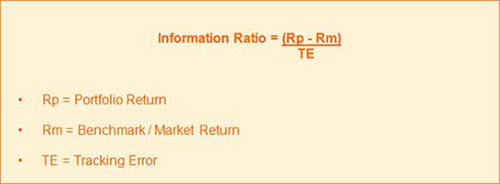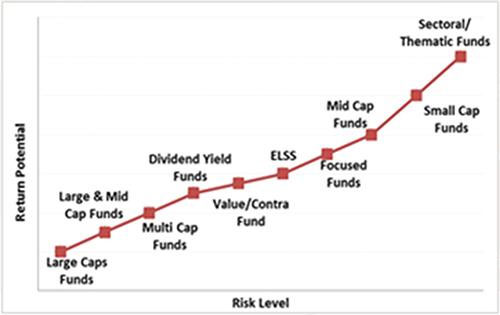Comparing Mutual Funds? Here’s Why You Should Use the Information Ratio
Divya Grover
Feb 17, 2025 / Reading Time: 7 min
Listen to Comparing Mutual Funds? Here’s Why You Should Use the Information Ratio
00:00
00:00
When selecting mutual funds, many investors often focus primarily on past performance. But what they tend to forget is that while returns are important, they only tell half the story.
Risk and returns are two sides of the same coin - for every level of return you seek, you also incur a certain level of risk.
Benjamin Graham, the father of value investing has famously said:
"The essence of investment management is the management of risks, not the management of returns."
Ignoring the risks involved and making investment decisions based solely on historical performance can be detrimental - not just to your wealth, but also to your peace of mind.
This raises an important question: how can you assess the risk associated with a mutual fund? More importantly, how do you determine whether the potential returns justify the risks?
Several financial ratios help measure the risk level of mutual funds, with the Information Ratio (IR) being one of the most critical ones. Understanding and applying this ratio when comparing mutual funds (within the same category and relative to the same benchmark) can help you determine which fund best aligns with your risk tolerance.
[Read: 7 Ratios to Assess Mutual Fund Risk And Identify the Best Mutual Funds]
What Is the Information Ratio?
The Information Ratio (IR) reflects a portfolio manager's skill and ability to generate excess returns relative to a benchmark. It also attempts to assess the consistency of performance by factoring in Tracking Error (TE) or Standard Deviation (SD) as part of its calculation.
SD is the measure of volatility, indicating how much a security's return fluctuates around its mean return.
A higher SD translates to a greater volatility in the underlying portfolio, whereas a lower SD indicates more stability.
TE represents the Standard Deviation of the difference between a fund's returns and its benchmark returns, showing how closely the fund follows the index.
The formula for the calculation of the Information Ratio is as below:

Here, Rp is the Portfolio Return, RM is the Market or Index Return, and TE is the Tracking Error.
Let's take an example where two mutual funds have both delivered 14% returns over a year, while the market index has returned 12%.
However, their Tracking Errors differ - 1.08 for Fund X and 1.05 for Fund Y.
Table: How Information Ratio Works
|
Fund X |
Fund Y |
| Fund Return |
14.0% |
14.0% |
| BSE 100 Index |
12.0% |
12.0% |
| Tracking Error |
1.08 |
1.05 |
| Ratio Calculation |
= (14-12) / 1.08 |
= (14-12) / 1.05 |
| Information Ratio |
1.85 |
1.90 |
(For illustrative purposes only)
If we want to pick one of these on the basis of their Information Ratio and apply the formula -- Portfolio Return Minus the Benchmark Return and Divided by the Tracking Error of the Fund, it will give us an Information Ratio of 1.85 for Fund X and 1.90 for Fund Y.
As an investor, you need to keep in mind that a higher IR indicates that the particular fund's manager has been more consistent in generating superior returns relative to the benchmark.
This means that when comparing mutual funds (within the same category and relative to the suitable benchmark), a fund with a higher IR is generally preferable.
In our example, this means that Fund Y is better than Fund X.
Why SEBI Has Mandated AMCs to Disclose Information Ratio for Risk-Adjusted Returns (RARs)
Recognising the crucial role of risk in investment decisions, SEBI has made it mandatory for mutual fund houses to disclose the periodic performance of mutual fund schemes along with their Risk-Adjusted Return (RAR).
RAR is a key metric that evaluates how much excess return a portfolio generates for each unit of risk taken.
A higher risk-adjusted return suggests that the fund has generated better returns relative to the risk taken. SEBI considers RAR a holistic measure of a scheme's overall performance.
Thus, to enhance transparency, SEBI now requires AMCs to disclose the Information Ratio for all equity-oriented mutual fund schemes daily on their websites, along with performance disclosures.
Additionally, the Association of Mutual Funds in India (AMFI) has been directed to ensure these disclosures are available on its website in a comparable, downloadable, and machine-readable format.
"Considering the significance of volatility of performance in determining the suitability of mutual fund schemes, Information Ratio is an established financial ratio to measure the risk-adjusted return of any scheme portfolio," the SEBI note stated.
The SEBI circular also shared a standard formula for AMCs to calculate IR for uniformity purposes:
IR = (Portfolio Rate of Returns less Benchmark Rate of Returns) ÷ Standard Deviation of Excess Return
Excess Return is determined by subtracting the Benchmark Return from the Portfolio Return (i.e., Portfolio Return - Benchmark Return).
SEBI has specified that the Tier 1 benchmark currently followed by the equity-oriented mutual fund scheme should be used for calculating Excess Return.
Understanding the Information Ratio (along with other ratios such as Sharpe Ratio and Sortino Ratio) allows you, the investor, to carefully shortlist mutual fund schemes that have consistently performed well not just in terms of returns but also in managing risk effectively.
When investing, it is crucial to set your risk-return expectations correctly.
Every category of mutual fund scheme - whether equity, debt, hybrid, gold, solution-oriented, or others - has distinctive traits in terms of asset allocation, investment strategy, and investment objective. Each one finds a unique place on the risk-return spectrum.
Graph: Risk-Return Spectrum of Equity Funds
 (For illustration purposes only)
(For illustration purposes only)
Mutual funds are also required to disclose an indicative risk-o-meter for every scheme, which is reviewed monthly. Depending on the investment mandate, a fund is classified as Low Risk, Moderately Low Risk, Moderate Risk, Moderately High Risk, High Risk, or Very High Risk. Additionally, AMCs must disclose how many times the risk level has changed over the year.
For you, the investor, it is crucial to pay attention to this information to understand the risk traits of a scheme.
Thoughtful investment decisions should be based on your personal risk profile, ensuring it aligns with the risk levels of the funds you select.
Investing should not be done in an ad hoc manner or by simply following what your neighbours, friends, relatives, or colleagues are doing. Remember, investing is a highly individualistic exercise - there is no one-size-fits-all approach.
To Conclude...
Investing in mutual funds is not just about chasing high returns - one needs to be mindful of the underlying risks.
So while it is easy to be lured by schemes that have generated high returns in recent past, it is crucial to evaluate a fund's ability to generate consistent returns across different market cycles.
Rather than viewing returns in isolation, assess Risk-Adjusted Returns (RAR) by utilising key risk-reward metrics like the Information Ratio (IR) to make informed decisions.
Beyond numbers, it would be prudent to understand the investment process and strategies followed by the fund house.
Ultimately, the best mutual fund is not just the one with the highest returns, but the one that aligns with your risk profile, investment objectives, financial goals, and the time horizon to achieve those goals.
Be a thoughtful investor.
Happy Investing!
Watch this video to understand the steps to compare mutual funds:
We are on Telegram! Join thousands of like-minded investors and our editors right now.
DIVYA GROVER is the co-editor for FundSelect, the flagship research service of PersonalFN. She is also the co-editor of DebtSelect. Divya is an avid reader which helps her in analysing industry trends and producing insightful articles for PersonalFN’s popular newsletter – Daily Wealth letter, read by over 1.5 lakh subscribers.
Divya joined PersonalFN in 2019 and has since then used stringent quantitative and qualitative parameters to analyse funds to provide honest and unbiased research to investors. She endeavours to enable investors to make an informed investment decision and thereby safeguard their wealth.
Disclaimer: Investment in securities market are subject to market risks, read all the related documents carefully before investing.
This article is for information purposes only and is not meant to influence your investment decisions. It should not be treated as a mutual fund recommendation or advice to make an investment decision in the above-mentioned schemes.